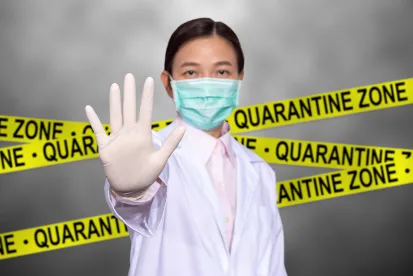The Centers for Disease Control and Prevention (CDC) has offered new COVID-19 guidance indicating that fully vaccinated individuals no longer need to wear masks or maintain physical distance from others in most settings. However, questions about employers’ compliance obligations and general duty expectations under the Occupational Safety and Health Act of 1970 (OSH Act) remain. For example, the CDC guidance conflicts with guidance from the Occupational Safety and Health Administration (OSHA), published in January 2021, that prohibits employers from distinguishing between workers who are and are not vaccinated.
The CDC guidance also conflicts with the COVID-19 standards and regulations in “State Plan” states like the ones in California and Virginia. Those states require strict social distancing and employee use of face coverings, regardless of employee vaccination status. They have yet to change in response to the CDC guidance.
Further, on May 13, 2021, CDC published “Interim Public Health Recommendations for Fully Vaccinated People.” It concluded that, except for public transportation, prisons, and homeless shelters, “[f]ully vaccinated people can resume activities without wearing a mask or physically distancing.” CDC published separate guidance for healthcare settings and schools. CDC cautiously pointed out its guidance was “subject to federal, state, local, tribal, or territorial laws, rules, and regulations, including local business and workplace guidance” (emphasis added). The exception, therefore, is that certain “State Plan” states have federal authority to enact and enforce occupational safety and health standards of their own. Twenty-seven states have authority under a grant program in the OSH Act to issue and enforce state-specific standards on behalf of OSHA itself.
Of the states that enacted standards specific to COVID-19, California, Oregon, and Virginia enacted the most comprehensive and restrictive standards. With respect to COVID-19, compliance obligations under their State Plans continue for employers in these states, regardless of any changes announced by CDC or OSHA. Until legally challenged, rescinded, or revised, these state standards remain law and continue to be enforced by the respective State Plan administrators: California Department of Industrial Relations’ Division of Occupational Safety and Health (Cal OSHA), Oregon Occupational Safety and Health (Oregon OSHA), and Virginia Department of Labor and Industry’s Division of Occupational Safety and Health (VOSH).
California
Cal OSHA has adopted Emergency Temporary Standards and regulations that require strict social distancing measures, employee use of face coverings (with limited exceptions), and COVID-19 hazard assessment. The standard goes beyond Virginia’s (see below) with controls such as mandatory workplace testing obligations, worker exclusions, and COVID-19 case investigations. Employers in California must conduct exhaustive COVID-19 inspections and employee training, as well as comply with local health department guidance related to COVID-19 in the workplace.
For now, California employers must maintain all preventive measures prescribed without regard for employee vaccination status. In addition, while Cal OSHA has updated its FAQs to provide that an employee’s vaccination status can be considered when determining exposure, worker exclusion requirements, and return-to-work criteria, the guidance conflicts with language in the regulations and deals only with required responses to a COVID-19 case, not preventive measures. Cal OSHA’s guidance also continues to require strict social distancing and mask use wherever contact with others is possible, whether indoors or outdoors. Cal OSHA is expected to release revisions to its Emergency Temporary Standards soon, and it will be considering revisions during an Emergency Standards Board meeting on June 3.
Oregon
Oregon employers are also contending with Oregon OSHA’s COVID-19 Prevention Rule, which is a permanent standard until rescinded or released. The Rule requires employers develop an infectious disease control plan, implement COVID-19 preventive measures (such as social distancing and employee use of face masks), and implement appropriate controls to reduce the potential spread for infectious diseases. These controls include optimization of HVAC systems, as well as enhanced cleaning and disinfection protocols.
Oregon OSHA also intentionally declined to address vaccinations in its final rule. It requires employers to treat vaccinated and unvaccinated employees equally, essentially discounting the CDC’s guidance. The agency has not adopted guidance on the impact of vaccination status on its COVID-19 Prevention Rule requirements, and it has not announced any plans to vacate, rescind, or modify its current requirements in response to CDC’s guidance.
Virginia
In Virginia, Governor Ralph Northam initially pushed a COVID-19 standard in 2020, and then he tried to scale it back in 2021.
On July 27, 2020, Virginia enacted an Emergency Temporary Standard, which included detailed requirements for disinfection, ventilation, infectious disease plans, hand sanitization, positive case reporting, and face coverings. On January 27, 2021, Virginia enacted a Permanent Standard that modified some of these requirements but kept most in place. Although vaccine distribution had begun by the date of its passage, the permanent standard drew no distinctions between vaccinated and unvaccinated workers.
Governor Northam has attempted to reverse universal face covering requirements with an Executive Order, but Virginia’s Permanent Standard remains the law in the workplace. The VOSH’s FAQs webpage states that fully vaccinated employees in non-healthcare settings may discontinue wearing face coverings, consistent with CDC guidance. However, VOSH has not rescinded, modified, or relaxed the Permanent Standard language and has not provide clear guidance for employers on how to manage employees’ vaccination status.
Dealing With Contradictions Among Guidance
In order to navigate the inconsistencies among CDC Guidance, federal OSHA guidance, and state requirements to resume normal operations, legal issues employers should think about as
they evaluate workplace health and safety needs include:
- OSHA and State Plans govern workplace health and safety. In general, workplace health and safety is governed under federal OSHA or a State Plan that has authority to have its own workplace health and safety standards. This means that employers need to be cognizant of workplace health and safety standards, regulations, and guidance for their industry, geographic location, and workplace environment in determining a path forward on COVID-19 preventive measures. In California, local health departments also have issued guidance that bears on the workplace and employers need to be mindful of those obligations.
- Employers that rush to lift face covering requirements in response to states lifting their COVID-19 restrictions might be jumping the gun. State Plans are required under the federal OSH Act to operate plans that are “at least as effective as” OSHA’s. Since OSHA has only provided a banner stating it is reviewing CDC guidance and employers may follow it, the agency could still come out with guidance or even a standard of its own that keeps some COVID-19 restrictions in place, including social distancing and use of face coverings in some circumstances. If that happens, employers that have lifted restrictions or relaxed COVID-19 protocols may have to reverse course and reinstate measures, which could pose challenges for employers as well as cause worker confusion and employee relations issues.
- States that want to govern workplace safety need to do so through OSHA. In 2020, the U.S. Supreme Court declined to allow a state to enforce its own COVID-19 workplace guidance because the OSH Act already provides an avenue for states to regulate in this area and the state was not operating under an approved state plan. For a state to be authorized to enact its own workplace health and safety regulations, the state must apply for State Plan status and then release standards that are consistent with the protections afforded under the OSH Act. In other words, if states want to regulate workplaces, they need to do have permission to do so from OSHA. Consequently, even though states may be lifting their executive orders and health office orders in response to changing COVID-19 statistics, employers in states under federal OSHA jurisdiction are not relieved from having to comply with federal OSHA requirements or their general duty obligations under the OSH Act.
As long as OSHA has not issued a workplace COVID-19 standard, or clarified in guidance how employers should account for employee vaccination status with respect to prevention of COVID-19 hazards in the workplace during the pandemic, employers may continue to have workplace health and safety obligations for both vaccinated and unvaccinated employees that conflict with the “unmasking” of many states. Employers, therefore, should be aware of and watch for updates from workplace health and safety agencies with primary authority over potential COVID-19 exposures in the workplace and follow their direction until the issues are clarified.




 />i
/>i

